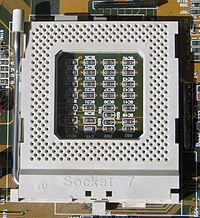Socket 7
 | |
| Type | ZIF |
|---|---|
| Chip form factors | PPGA, CPGA |
| Contacts | 321 |
| FSB protocol | P5 |
| FSB frequency | 66 - 83 MHz System Clock |
| Voltage range | 2.5V - 3.5V |
| Processors | 75-233 MHz Intel Pentium, AMD K5 through K6, Cyrix 6x86 (and MX) P120 - P233 |
This article is part of the CPU socket series | |
Socket 7 is a physical and electrical specification for an x86-style CPU socket on a personal computer motherboard. The socket supersedes the earlier Socket 5, and accepts Pentium microprocessors manufactured by Intel, as well as compatibles made by Cyrix/IBM, AMD, IDT and others.
Socket 7 was the only socket that accepted such a wide range of CPUs, (range of speeds and CPUs from different manufacturers)[citation needed].
Differences between Socket 5 and Socket 7 are that Socket 7 has an extra pin and is designed to provide dual split rail voltage, as opposed to Socket 5's single voltage. (However, not all motherboard manufacturers supported the dual voltage on their boards initially.) Socket 7 is backwards compatible; a Socket 5 CPU can be placed in a Socket 7 motherboard.
Supported processors include: 2.5V - 3.5V Pentium 75-200 MHz and Pentium MMX 166-233 MHz, AMD K5 through K6, Cyrix 6x86 (and MX) P120 - P233, the entire IDT WinChip series (180-250 MHz) and the Rise Technology MP6 family
Socket 7 uses a SPGA socket, either a 296 pin LIF arranged at 37x37 (which is very rare), or the much more common 321 pin ZIF arranged at 19x19.
An extension, Super Socket 7, was designed to allow the AMD K6-2 and AMD K6-III chips to operate at a higher clock rate and use AGP.
References
This article is based on material taken from the Free On-line Dictionary of Computing prior to 1 November 2008 and incorporated under the "relicensing" terms of the GFDL, version 1.3 or later.
